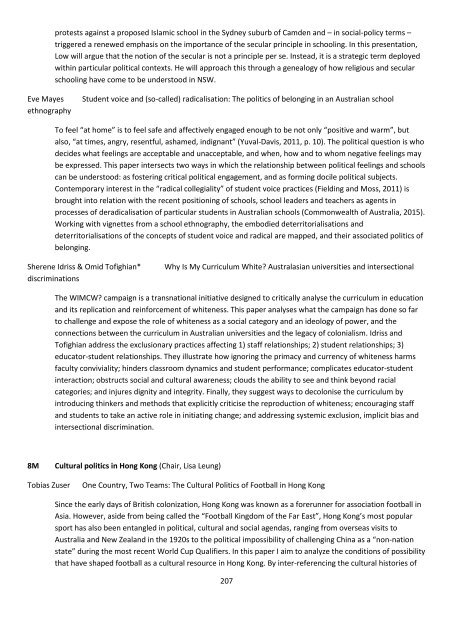Crossroads in Cultural Studies Conference 14-17th December 2016 Program Index
Crossroads-2016-final-draft-program-30-Nov
Crossroads-2016-final-draft-program-30-Nov
You also want an ePaper? Increase the reach of your titles
YUMPU automatically turns print PDFs into web optimized ePapers that Google loves.
protests aga<strong>in</strong>st a proposed Islamic school <strong>in</strong> the Sydney suburb of Camden and – <strong>in</strong> social-policy terms –<br />
triggered a renewed emphasis on the importance of the secular pr<strong>in</strong>ciple <strong>in</strong> school<strong>in</strong>g. In this presentation,<br />
Low will argue that the notion of the secular is not a pr<strong>in</strong>ciple per se. Instead, it is a strategic term deployed<br />
with<strong>in</strong> particular political contexts. He will approach this through a genealogy of how religious and secular<br />
school<strong>in</strong>g have come to be understood <strong>in</strong> NSW.<br />
Eve Mayes<br />
ethnography<br />
Student voice and (so-called) radicalisation: The politics of belong<strong>in</strong>g <strong>in</strong> an Australian school<br />
To feel “at home” is to feel safe and affectively engaged enough to be not only “positive and warm”, but<br />
also, “at times, angry, resentful, ashamed, <strong>in</strong>dignant” (Yuval-Davis, 2011, p. 10). The political question is who<br />
decides what feel<strong>in</strong>gs are acceptable and unacceptable, and when, how and to whom negative feel<strong>in</strong>gs may<br />
be expressed. This paper <strong>in</strong>tersects two ways <strong>in</strong> which the relationship between political feel<strong>in</strong>gs and schools<br />
can be understood: as foster<strong>in</strong>g critical political engagement, and as form<strong>in</strong>g docile political subjects.<br />
Contemporary <strong>in</strong>terest <strong>in</strong> the “radical collegiality” of student voice practices (Field<strong>in</strong>g and Moss, 2011) is<br />
brought <strong>in</strong>to relation with the recent position<strong>in</strong>g of schools, school leaders and teachers as agents <strong>in</strong><br />
processes of deradicalisation of particular students <strong>in</strong> Australian schools (Commonwealth of Australia, 2015).<br />
Work<strong>in</strong>g with vignettes from a school ethnography, the embodied deterritorialisations and<br />
deterritorialisations of the concepts of student voice and radical are mapped, and their associated politics of<br />
belong<strong>in</strong>g.<br />
Sherene Idriss & Omid Tofighian*<br />
discrim<strong>in</strong>ations<br />
Why Is My Curriculum White? Australasian universities and <strong>in</strong>tersectional<br />
The WIMCW? campaign is a transnational <strong>in</strong>itiative designed to critically analyse the curriculum <strong>in</strong> education<br />
and its replication and re<strong>in</strong>forcement of whiteness. This paper analyses what the campaign has done so far<br />
to challenge and expose the role of whiteness as a social category and an ideology of power, and the<br />
connections between the curriculum <strong>in</strong> Australian universities and the legacy of colonialism. Idriss and<br />
Tofighian address the exclusionary practices affect<strong>in</strong>g 1) staff relationships; 2) student relationships; 3)<br />
educator-student relationships. They illustrate how ignor<strong>in</strong>g the primacy and currency of whiteness harms<br />
faculty conviviality; h<strong>in</strong>ders classroom dynamics and student performance; complicates educator-student<br />
<strong>in</strong>teraction; obstructs social and cultural awareness; clouds the ability to see and th<strong>in</strong>k beyond racial<br />
categories; and <strong>in</strong>jures dignity and <strong>in</strong>tegrity. F<strong>in</strong>ally, they suggest ways to decolonise the curriculum by<br />
<strong>in</strong>troduc<strong>in</strong>g th<strong>in</strong>kers and methods that explicitly criticise the reproduction of whiteness; encourag<strong>in</strong>g staff<br />
and students to take an active role <strong>in</strong> <strong>in</strong>itiat<strong>in</strong>g change; and address<strong>in</strong>g systemic exclusion, implicit bias and<br />
<strong>in</strong>tersectional discrim<strong>in</strong>ation.<br />
8M<br />
<strong>Cultural</strong> politics <strong>in</strong> Hong Kong (Chair, Lisa Leung)<br />
Tobias Zuser<br />
One Country, Two Teams: The <strong>Cultural</strong> Politics of Football <strong>in</strong> Hong Kong<br />
S<strong>in</strong>ce the early days of British colonization, Hong Kong was known as a forerunner for association football <strong>in</strong><br />
Asia. However, aside from be<strong>in</strong>g called the “Football K<strong>in</strong>gdom of the Far East”, Hong Kong’s most popular<br />
sport has also been entangled <strong>in</strong> political, cultural and social agendas, rang<strong>in</strong>g from overseas visits to<br />
Australia and New Zealand <strong>in</strong> the 1920s to the political impossibility of challeng<strong>in</strong>g Ch<strong>in</strong>a as a “non-nation<br />
state” dur<strong>in</strong>g the most recent World Cup Qualifiers. In this paper I aim to analyze the conditions of possibility<br />
that have shaped football as a cultural resource <strong>in</strong> Hong Kong. By <strong>in</strong>ter-referenc<strong>in</strong>g the cultural histories of<br />
207


